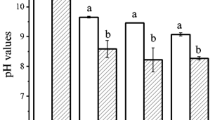Abstract
Mechanochemistry is gaining increasing interest as an efficient tool for solvent-free organic transformations. Recently, it was applied to perform the Maillard reaction of glucose with various amino acids that lead to the selective formation of Schiff bases and their Amadori rearrangement products. In this study, we report the thermal properties of the mechanochemically generated glucose–histidine reaction mixtures. Direct video recordings of their melting behavior show that the browning of the ball-milled mixtures starts at lower temperatures and proceed more slowly compared to the non-milled mixtures. Furthermore, pyrolysis of ball-milled mixtures generated more pyrazines and fewer furan derivatives compared to the non-milled mixtures. The chemical composition of the ball-milled glucose–histidine was also investigated in depth by high-resolution mass spectrometry. The decarboxylation and C2–C3 sugar chain cleavage reactions were identified as the most important transformations during ball milling. These findings further support the utility of mechanochemically generated mixtures as potential Maillard flavor and browning precursors.




Similar content being viewed by others
References
Mottram DS (1994) Flavor compounds formed during the Maillard reaction. In. ACS Publications. https://doi.org/10.1021/bk-1994-0543.ch010
Sucan MK, Weerasinghe DK (2005) Process and reaction flavors: An overview. In. ACS Publications. https://doi.org/10.1021/bk-2005-0905.ch001
Kerler J, Winkel C, Davidek T, Blank I (2010) Basic chemistry and process conditions for reaction flavours with particular focus on Maillard-type reactions. Food Flav Technol. https://doi.org/10.1002/9781444317770.ch3
Nursten HE (2005) The Maillard reaction: chemistry, biochemistry, and implications. Royal Soc Chem. https://doi.org/10.1039/9781847552570
Hodge JE (1953) Dehydrated foods, chemistry of browning reactions in model systems. J Agric Food Chem 1(15):928–943. https://doi.org/10.1021/jf60015a004
Yaylayan VA (1997) Classification of the Maillard reaction: a conceptual approach. Trends Food Sci Technol 8(1):13–18. https://doi.org/10.1016/S0924-2244(96)20013-5
Yaylayan V, Fichtali J, Van de Voort F (1992) Production of Maillard reaction flavour precursors by extrusion processing. Food Res Int 25(3):175–180. https://doi.org/10.1016/0963-9969(92)90134-Q
Yaylayan VA, Matni G, Paré JJ, Bélanger JM (1997) Microwave-assisted synthesis and extraction of selected Maillard reaction products. J Agric Food Chem 45(1):149–152. https://doi.org/10.1021/jf960395z
Ong OX, Seow Y-X, Ong PK, Zhou W (2015) High-intensity ultrasound production of Maillard reaction flavor compounds in a cysteine–xylose model system. Ultrason Sonochem 26:399–407. https://doi.org/10.1016/j.ultsonch.2015.01.001
Viton F, Oertling HR, Fumeaux R (2017) Mechanical generation of flavour compositions. Patent No. US20170079316A1 edn. U.S. Patent US20170079316A1,
James SL, Adams CJ, Bolm C, Braga D, Collier P, Friščić T, Grepioni F, Harris KD, Hyett G, Jones W (2012) Mechanochemistry: opportunities for new and cleaner synthesis. Chem Soc Rev 41(1):413–447. https://doi.org/10.1039/C1CS15171A
Margetic D, Štrukil V (2016) Mechanochemical organic synthesis. Elsevier, Amsterdam
Schmeyers J, Toda F, Boy J, Kaupp G (1998) Quantitative solid–solid synthesis of azomethines. J Chem Soc Perkin Transact 2(4):989–994. https://doi.org/10.1039/a704633b
Kaupp G, Schmeyers J, Boy J (2000) Quantitative solid-state reactions of amines with carbonyl compounds and isothiocyanates. Tetrahedron 56(36):6899–6911. https://doi.org/10.1016/S0040-4020(00)00511-1
Schmidt R, Martin Scholze H, Stolle A (2016) Temperature progression in a mixer ball mill. Int J Indust Chem 7(2):181–186. https://doi.org/10.1007/s40090-016-0078-8
Kulla H, Wilke M, Fischer F, Röllig M, Maierhofer C, Emmerling F (2017) Warming up for mechanosynthesis–temperature development in ball mills during synthesis. Chem Commun 53(10):1664–1667. https://doi.org/10.1039/c6cc08950j
Xing H, Yaylayan V (2020) Mechanochemical generation of Schiff bases and Amadori products and utilization of diagnostic MS/MS fragmentation patterns in negative ionization mode for their analysis. Carbohyd Res 495:108091. https://doi.org/10.1016/j.carres.2020.108091
Xing H, Mossine VV, Yaylayan V (2020) Diagnostic MS/MS fragmentation patterns for the discrimination between Schiff bases and their Amadori or Heyns rearrangement products. Carbohyd Res 491:107985. https://doi.org/10.1016/j.carres.2020.107985
Hammerer F, Loots L, Do J-L, Therien J, Nickels CW, Friscic T, Auclair K (2018) Solvent-free enzyme activity: quick, high-yielding mechano-enzymatic hydrolysis of cellulose into glucose. Angew Chem Int Ed. https://doi.org/10.1002/anie.201711643
Descamps M, Aumelas A, Desprez S, Willart JF (2015) The amorphous state of pharmaceuticals obtained or transformed by milling: sub-Tg features and rejuvenation. J Non-Cryst Solids 407:72–80. https://doi.org/10.1016/j.jnoncrysol.2014.08.055
Röper H, Röper S, Heyns K, Meyer B (1983) N.m.r. spectroscopy of N-(1-deoxy-d-fructos-1-yl)-l-amino acids (“fructose-amino acids”). Carbohydrate Research 116(2):183–195. https://doi.org/10.1016/0008-6215(83)88108-7
Hemmler D, Roullier-Gall C, Marshall JW, Rychlik M, Taylor AJ, Schmitt-Kopplin P (2018) Insights into the chemistry of non-enzymatic browning reactions in different ribose-amino acid model systems. Sci Rep 8(1):16879. https://doi.org/10.1038/s41598-018-34335-5
Hofmann T (1999) Quantitative studies on the role of browning precursors in the Maillard reaction of pentoses and hexoses with L-alanine. Eur Food Res Technol 209(2):113–121. https://doi.org/10.1007/s002170050468
Acknowledgements
The authors acknowledge funding for this research from Natural Sciences and Engineering Research Council of Canada (NSERC), Le Fonds de Recherche du Québec–Nature et Technologie (FRQNT), and the China Scholarship Council (CSC).
Author information
Authors and Affiliations
Corresponding author
Ethics declarations
Compliance with ethics requirements
This article does not contain any studies with human or animal subjects.
Conflicts of interest
There are no conflicts to declare.
Additional information
Publisher's Note
Springer Nature remains neutral with regard to jurisdictional claims in published maps and institutional affiliations.
Electronic supplementary material
Below is the link to the electronic supplementary material.
Rights and permissions
About this article
Cite this article
Xing, H., Yaylayan, V. Investigation of thermo-chemical properties of mechanochemically generated glucose–histidine Maillard reaction mixtures . Eur Food Res Technol 247, 111–120 (2021). https://doi.org/10.1007/s00217-020-03611-y
Received:
Revised:
Accepted:
Published:
Issue Date:
DOI: https://doi.org/10.1007/s00217-020-03611-y




